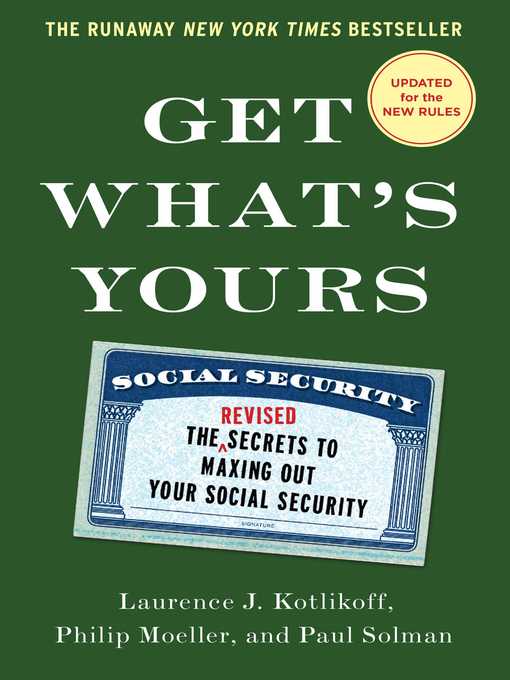Get What's Yours
The Revised Secrets to Maxing Out Your Social Security
Get What's Yours has proven itself to be the definitive book about how to navigate the forbidding maze of Social Security and emerge with the highest possible benefits. It is an engaging manual of tactics and strategies written by well-known financial commentators that is unobtainable elsewhere. You could try reading all 2,728 rules of the Social Security system (and the thousands of explanations of these rules), but academia's Kotlikoff, the popular press's Moeller, and public television's Solman explain the Social Security system just as comprehensively, and a lot more comprehensibly. Moreover, they demonstrate that what you don't know can seriously hurt you: wrong decisions about which Social Security benefits to apply for cost individual retirees tens of thousands of dollars in lost income every year. (Some of those people are even in the book.)
Changes to Social Security that take effect in 2016 make it more important than ever to wait as long as possible (until age 70, if possible) to claim Social Security benefits. The new law also has significant implications for those who wish to claim divorced spousal benefits (and how many Social Security recipients even know about divorced spousal benefits?). Besides addressing these and other issues, this revised edition contains a chapter explaining how Medicare rules can shape Social Security decisions.
Many other personal-finance books briefly address Social Security, but none offers the full, authoritative, yet conversational analysis of Get What's Yours.
Get What's Yours explains Social Security benefits through basic strategies and stirring stories. It covers the most frequent benefit scenarios faced by married retired couples; by divorced retirees; by widows and widowers. It explains what to do if you're a retired parent of dependent children; disabled; an eligible beneficiary who continues to work. It addresses the tax consequences of your choices, as well as the financial implications for other investments. It does all this and more.
There are more than 52 million Americans aged 54 to 69. Ten thousand of them reach Social Security's full retirement age of 66 every day. For all these people—and for their families and friends—Get What's Yours has proven to be an invaluable, and therefore indispensable, tool.
-
Creators
-
Publisher
-
Release date
February 17, 2015 -
Formats
-
Kindle Book
-
OverDrive Read
- ISBN: 9781476772318
-
EPUB ebook
- ISBN: 9781476772318
- File size: 1401 KB
-
-
Languages
- English
-
Reviews
-
Publisher's Weekly
December 15, 2014
Social Security is widely mistrusted and little understood by most Americans, and with good reason: the program’s operating manual contains 2,728 core rules, and thousands of additional instructions. This can’t-miss guide to the system comes from Kotlikoff, a Boston University economist; Moller, an expert on aging; and Solman, a PBS NewsHour economics correspondent. After a conversation among all three about their own retirement planning revealed how confusing the system is, they set out to write a book pointing out traps and ways to maximize the reader’s retirement benefits. With a little tough love (reminding readers not to overestimate their own knowledge or objectivity), they explain the ins and outs of lesser-known features, such as survivor and spousal benefits. Readers are also led through the decision of whether to claim early or delay retirement entirely, the intricacies of marital-status changes, and the options for those who are married, divorced, widowed, or single. The writing is detail heavy but clear enough for even the most intimidated reader, with a concluding cheat sheet helpfully summing up the book’s suggestions. The authors’ palpable fervor to help readers get back what they’ve paid will energize readers to claim what is rightfully theirs. Agent: Alice Martell, Martell Agency. -
Library Journal
February 15, 2015
With the goal to make sense of when and how to collect Social Security, authors Kotlikoff (William Fairfield Warren Distinguished Professor, Boston Univ.; coauthor, Spend 'til the End), Philip Moeller (research fellow, Sloan Ctr. on Aging & Work, Boston Coll.; contributing writer, Money) and Paul Solman (Brady-Johnson Distinguished Practitioner in Grand Strategy, Yale Univ.; business and economics correspondent, PBS NewsHour) begin with the basics, explaining exactly what Social Security is and which benefits are part of the system. Using true-to-life examples, they walk readers through their three rules for maximizing Social Security income by illustrating the importance of waiting to collect, taking all available benefits, and timing the collection of benefits correctly. There is advice for those who are widowed or divorced, for individuals with disabilities, and for those who have worked in both covered and noncovered jobs. Especially timely is the chapter designed to help gay couples understand how the legalization of same-sex marriage affects entitlement to Social Security benefits. Extras include a sample application for retirement insurance benefits in which the authors insert cautions and guidance and a glossary that demystifies essential terminology and acronyms. VERDICT This book works as a thorough overview and as a reference for those with specific questions about Social Security. The authors present the information from the unwieldy system clearly but without dumbing it down. [See Prepub Alert, 8/22/14.]--Joan Pedzich, formerly with Harris Beach PLLC, Pittsford, NY
Copyright 2015 Library Journal, LLC Used with permission.
-
Formats
- Kindle Book
- OverDrive Read
- EPUB ebook
subjects
Languages
- English
Loading
Why is availability limited?
×Availability can change throughout the month based on the library's budget. You can still place a hold on the title, and your hold will be automatically filled as soon as the title is available again.
The Kindle Book format for this title is not supported on:
×Read-along ebook
×The OverDrive Read format of this ebook has professional narration that plays while you read in your browser. Learn more here.


